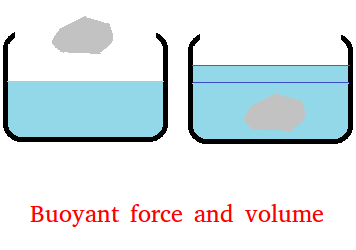Buoyant force
Buoyant force is the force that pushes object up when the object is submerged in water. What is buoyancy? Most of us have experienced buoyancy before.
When an object is submerged in liquid and you try to lift the object, you feel that the object is less heavy. This apparent loss of weight of the object is called buoyancy.
Why is the object less heavy? It is the result of pressure acting against the object.
For example, submerge a rock in water and then try to lift it. The rock will of course be a little easier to lift since the weight is less.
The figure below shows the forces acting on the rock with red and blue arrows.

The
forces (shown with blue arrow) acting horizontally on the left and on
the right cancel each other. As a result, the rock will not move
sideways.
However, the forces acting vertically do not cancel each other.
Because the bottom of the boulder is deeper in the water, the forces acting at the bottom are greater than the forces acting on top of the boulder. This will result in a net force going upward and that is what we call buoyant force.
Cases to consider:
- When the weight of the object is bigger than the buoyant force, the object will sink and reach the bottom.
- When the weight of the object is the same as the buoyant force, the object will remain at some specific level.
- When the weight of the object is smaller than the buoyant force, the object will float at the surface.
Buoyant force and the volume of object
When you submerge an object in a container, the water will rise. The volume of water that rises is equal to the volume of the object that is now under water.

This makes sense since when the object is under water, it has to
occupy some space. It basically takes the space of the water that is
displaced or pushed aside.
In our figure above, the amount of water that is displaced in between the blue line and the red line. It is the volume of this water that is equal to the volume of the rock.
Be careful! It is not about how heavy the rock is. It is about how much space it takes inside the container. The more space it takes, the more water will be pushed aside.
The above fact gives you a nice way to compute the volume of some
irregular shapes. Just submerge the object in a container filled with
water. As you submerge the object, water will spill outside of course.
Collect the water in another container such as a rectangular prism.
After the object is completely submerged, you can now compute the
volume. The volume of the water in that rectangular prism is the same as
the volume of the object.
If you are still having a hard time understanding this, do this experiment:
1. Get a plastic cup and fill it with water.
2. Get another empty plastic cup.
3. Using the bottom of the empty plastic cup, try to put it inside the cup filled with water until the bottom of empty plastic cup touches the bottom of the cup filled with water.
You should notice that most of the water came out.
It is so because the empty cup almost occupied the entire space
The amount of water that came out is equal to almost the entire volume of the cup.